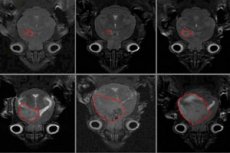New publications
Treatment for glioblastoma has shown encouraging results
Last reviewed: 03.07.2025

All iLive content is medically reviewed or fact checked to ensure as much factual accuracy as possible.
We have strict sourcing guidelines and only link to reputable media sites, academic research institutions and, whenever possible, medically peer reviewed studies. Note that the numbers in parentheses ([1], [2], etc.) are clickable links to these studies.
If you feel that any of our content is inaccurate, out-of-date, or otherwise questionable, please select it and press Ctrl + Enter.

Researchers at Memorial Sloan Kettering Cancer Center have identified a small molecule called gliocidin that kills glioblastoma cells without harming healthy cells. The discovery could offer a new therapeutic approach to treating this aggressive brain tumor.
Why is glioblastoma difficult to treat?
Glioblastoma remains one of the most lethal primary brain tumors. Current treatments only marginally increase patient survival. Key challenges:
- Tumor heterogeneity: Glioblastoma is made up of many cell types, making it difficult to effectively target all of them.
- Few genetic alterations: The tumor lacks significant drug targets.
- Immunosuppressive environment: The tumor suppresses the body's immune response.
- Blood-brain barrier: Most drugs are unable to penetrate the brain.
How was gliocidin discovered?
In a study published in the journal Nature, titled "Gliocidin is a nicotinamide-mimetic prodrug that targets glioblastoma," the team conducted a high-throughput screen of more than 200,000 chemical compounds on mouse glioblastoma cells.
Gliocidin turned out to be a compound that is selectively toxic to glioblastoma cells and safe for healthy cells.
Mechanism of action of gliocidin
To elucidate the mechanism of action, the researchers used a CRISPR–Cas9 screen to identify genes that influence gliocidin’s effectiveness against glioblastoma. They found that gliocidin:
- Blocks the enzyme IMP dehydrogenase 2 (IMPDH2), which is involved in the synthesis of guanine nucleotides.
- This leads to:
- Nucleotide imbalance
- Stress during DNA replication,
- Death of tumor cells.
Glyocidin is a prodrug that is activated in the body. Once activated, it forms a form called gliocidin adenine dinucleotide (GAD), which binds to IMPDH2 and blocks its function.
Efficacy in mouse model
In experiments on mice, gliocidin has shown the ability to:
- Penetrate the blood-brain barrier.
- Slow down tumor growth.
- Extend survival.
Particularly significant results were obtained when gliocidin was combined with the chemotherapeutic drug temozolomide (which enhances the expression of the enzyme NMNAT1, which is involved in the activation of gliocidin).
Benefits of Gliocidin
- Safety: Mice showed no weight loss, changes in major organs, or immune system problems.
- High efficacy: The combination of gliocidin with temozolomide resulted in a significant improvement in survival.
Conclusion
Gliocidin shows potential as a new therapeutic approach for the treatment of glioblastoma. Its successful trials in mice make it a promising candidate for future clinical trials.
